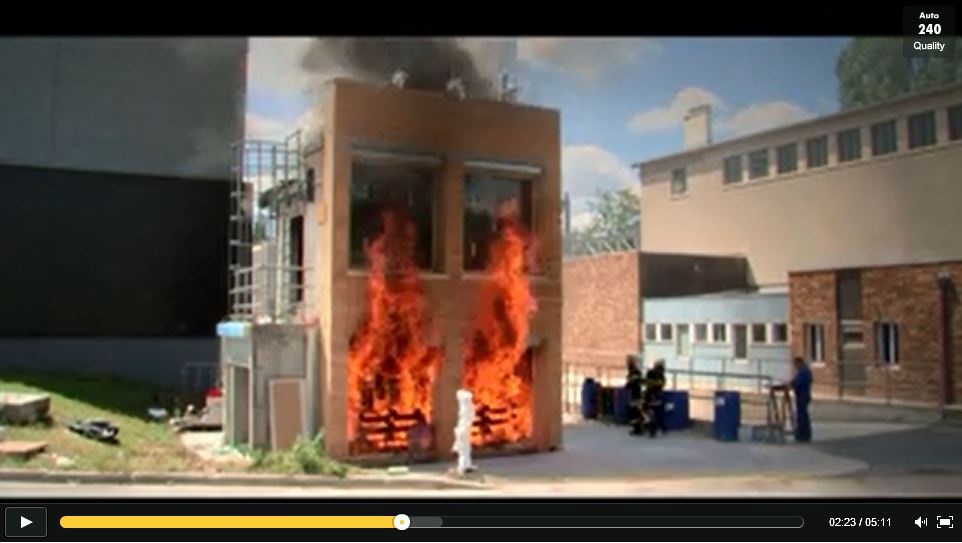GERMANY: A firetest on a straw bale wall with 6 cm limeplaster (graefix 73 pajalith). The test was made 2012 on iBMB Braunschweig.
The firetest for the 6 cm plaster was successful so the plaster (the straw bale-modules with plaster) may be installed on 5 story straw bale buildings – as in this example on the “Norddeutsches Zentrum für Nachhaltiges Bauen” (North German Centre for Sustainable Construction (NZNB))! Here are the results in detail
CZECH REP.: Fire Resistance Test of Load Bearing Straw Bale Wall has been carried out within the Project „Selected Properties of Natural Based and Other Materials, Structural Components and Buildings” supported by the Ministry of Industry and Trade of the CR in June 2011. The wall is created by 7 layers of straw bales of the size 50 x 42 x 50 cm. The bales are compressed with the timber during the construction and at the end with the load which simulates the construction load. Basic volume weight of the bales was 77 kg/m3 and after the compression it was 93 kg/m3. The surface was covered with steel mesh and plastered with clay plaster from interior and lime plaster from exterior. The fire resistance of this structure is 120 minutes! The experiment took 2 hours and 26 minutes and it collapsed due to limits in load bearing capacity. Final report is available at kps.fsv.cvut.cz/
AUSTRIA: Waldland (in Cooperation with Kreativer Holzbau, Bauatelier Schmelz & Salomon):
European Technical Approval ETA-10/0032 (CE-certification), valid until 11.04.2015
Values for Building StrawBales (Baustrohballen):
Humidity: < 15 % of weight
Density 95–120 kg/m3 (Nenndichte: 105 kg/m3)
Wasseraufnahme: max. 6,96 kg/m3
Strömungswiderstand: mind. 1,9 kPa s/m2 / 2,7 kPa s/m2
Wärmeleitfähigkeit: Nennwert = 0,046 W/m.K
Wärmeleitfähigkeit-Bemessungswert = 0,050 W/m.K
Brandverhalten nach EN 13051-1: Klasse E
Resistenz gegen biologische Einwirkungen: Klasse 2
Metallkorrosion fördernde Eigenschaft: kein Potential festgestellt.
Here you can see the the ETA test-certificate (in german)
UK 1: Bee Rowan (straworks): Latest official fire test to EN certification standard BSEN 1365-1 1999 on 25.10. 2013 on a 3m wide x 2.6m high timber stud wall with 4 studs (9 x 9 cm in the centre of the straw bale wall, i.e. 17.5 cm from the plaster surface) filled with straw bales of density 112 kg/m3, under load (to simulate a two-storey building) filled on one side with 25mm clay (1 part clay, 3 parts sand, 1 part straw as fibre reinforcement) on a clay pre-sprinkler (with approx. The side facing away from the fire (outside) was not plastered or planked (i.e. only straw).
During the 2 hours (120 min) for which the fire test was designed, no cracks occurred on the entire plaster surface (only slight cracks at the connection to the ring beam and to the lateral fire chamber), after 02:15 the test was stopped because the sealing (rock wool) to the fire chamber installed by the testing institute TRADA failed. Until then, no test with 120 min fire resistance had ever been carried out on a building component under load. After the fire test, the studs were completely statically intact and showed only a slight discolouration due to the maximum temperatures of 93-94° C measured in this area (charring only begins at approx. 200° C). After the test, the clay plaster was hard-fired to a depth of 8-9 mm, followed by a layer of carbonated clay.
Here you can download the certificate and the results and test-description.
UK 2: Researchers at the University of Bath tested a pre-fabricated panel, as used in the construction of Balehaus@Bath, for fire safety by exposing it to temperatures over 1000°C. To reach the required standard the panel had to withstand the heat for more than 30 minutes. Over two hours later – four times as long as required – the panel had still not failed (source: http://www.bath.ac.uk/news/2009/11/18/balehaus-opening/).

FRANCE: Film du CSTB (klick in the picture for a link to the Oliver Gaujard-site) présenté à Batimat 2013 sur le Groupe Scolaire passif et paille d’Issy-les-Moulineaux.
Le CSTB a réalisé et présenté à Batimat 2013 un film portant sur notre projet du Groupe Scolaire d’Issy-les-Moulineaux. L’école et le club house sont en structure et planchers bois; les parois, les murs et la toiture sont isolés en bottes de paille. La vidéo revient notamment sur l’essai feu que nous avons mis en place pour confirmer le respect de la jonction plancher-façade vis-à-vis de l’IT249 (Instruction Technique du Règlement Incendie en ERP).
Here you can download the test certificate in french as PDF
FRANCE 2: Maison isolée en paille-résistance au feu
AUSTRALIA: STRAW HOUSE BY JOOST CSIRO BUSHFIRE SIMULATION + FIRE SAFETY TEST, 15th FEBRUARY 2012
30 minutes radiant heat exposure at 2.5kw/m2 stepping up to 5, 10, 20, 30 and then 40kw/m2 at the 30 minutes mark. Intensified to over 100kw/m2 for a period of 110 seconds – simulating a MAJOR fire front and worst case bushfire scenario. External temperatures reached above 1000 degrees celsius. Maximum internal temperature reached 35 degrees celsius. House by Joost withheld the extremes of the test. The steel frame of the building approached 100-110 degrees celsius during the test and maintained integrity. The MGO (magnesium oxide board) cladding performed incredibly well and there was no significant damage.The glazing remained intact and there was no breach to the interior.
More information at http://byjoost.com/

